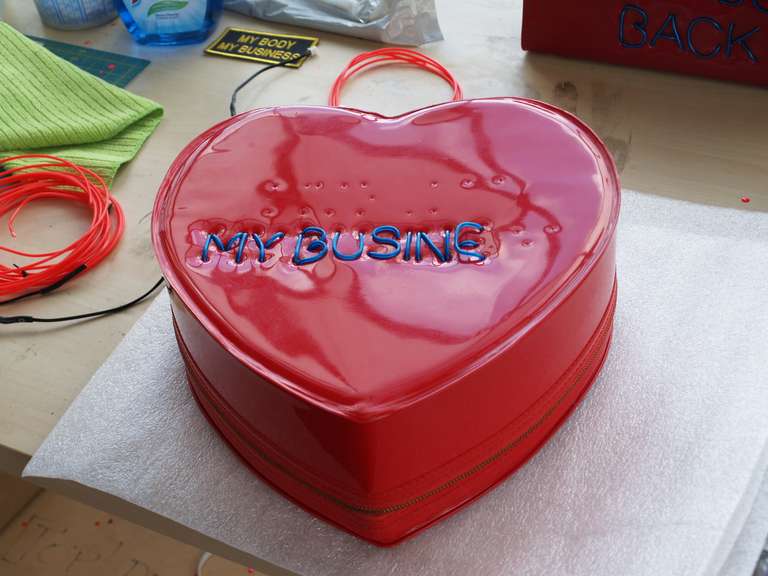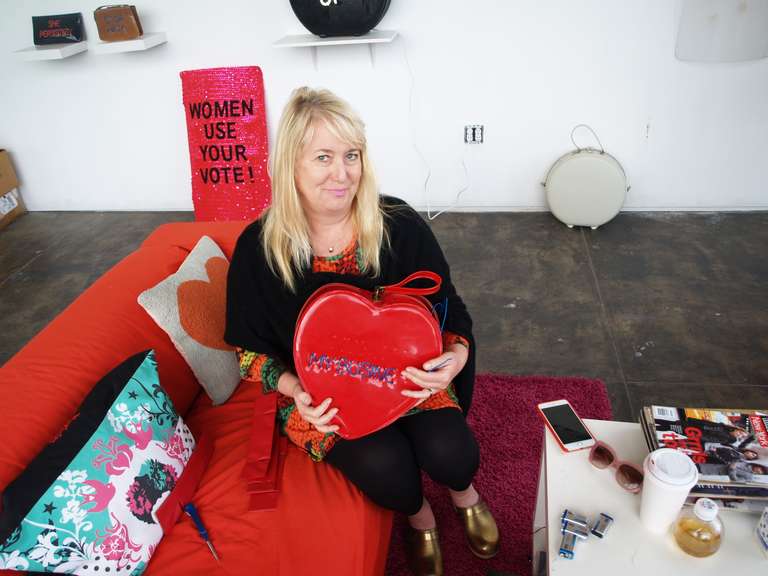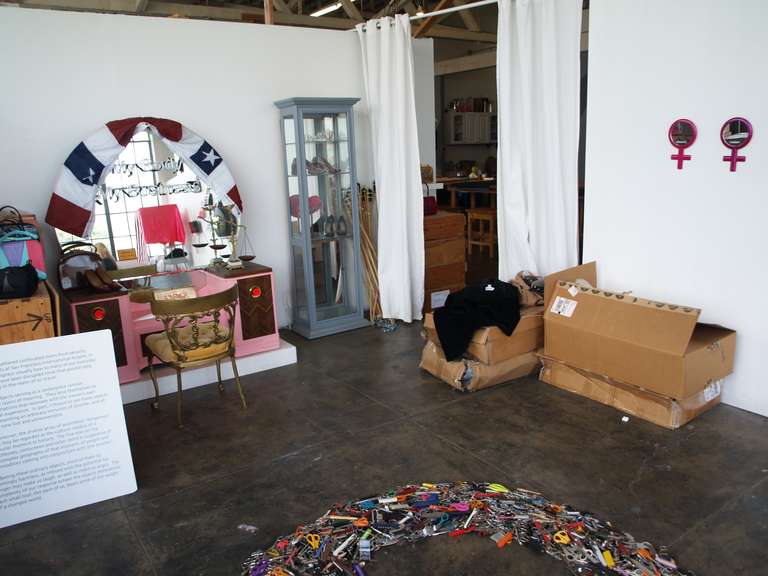Your Purse is a Tiny, Wearable Billboard. Michele Pred Told Me So.
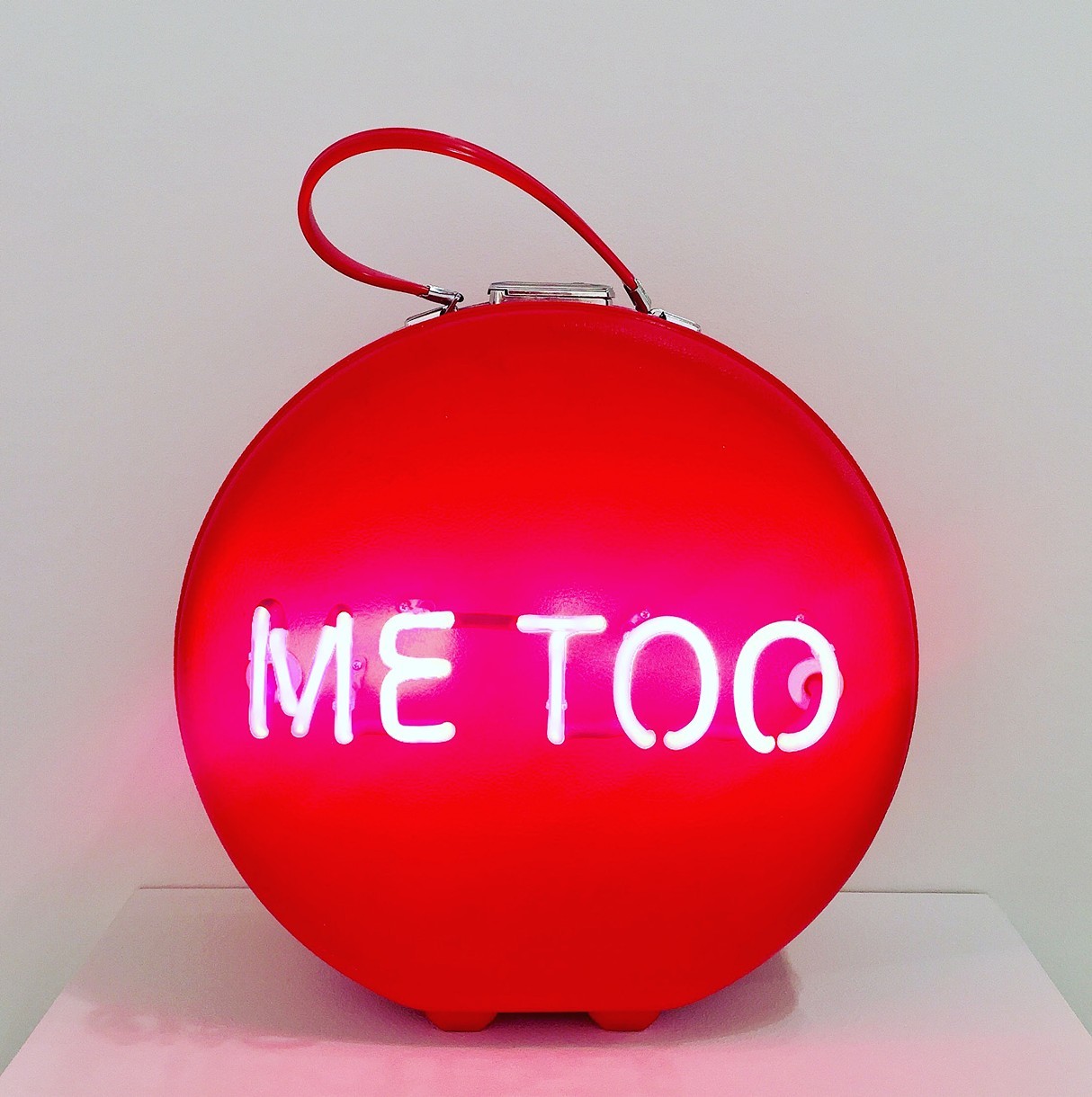
Join us on conceptual/installation/social practice artist Michele Pred's red couch in her white-walled studio at Faultline Artspace in East Oakland, California. Pred is a Swedish-American artist who started the "Art of Equal Pay" movement to encourage female and non-binary artists to charge more. She's got a billboard in New York City all about it. With us, she talks about the "Power of the Purse" series, a collection of vintage purses that blink light-up political messages. Does your purse do that? Not yet. Her couch is from IKEA and her work is from the heart.
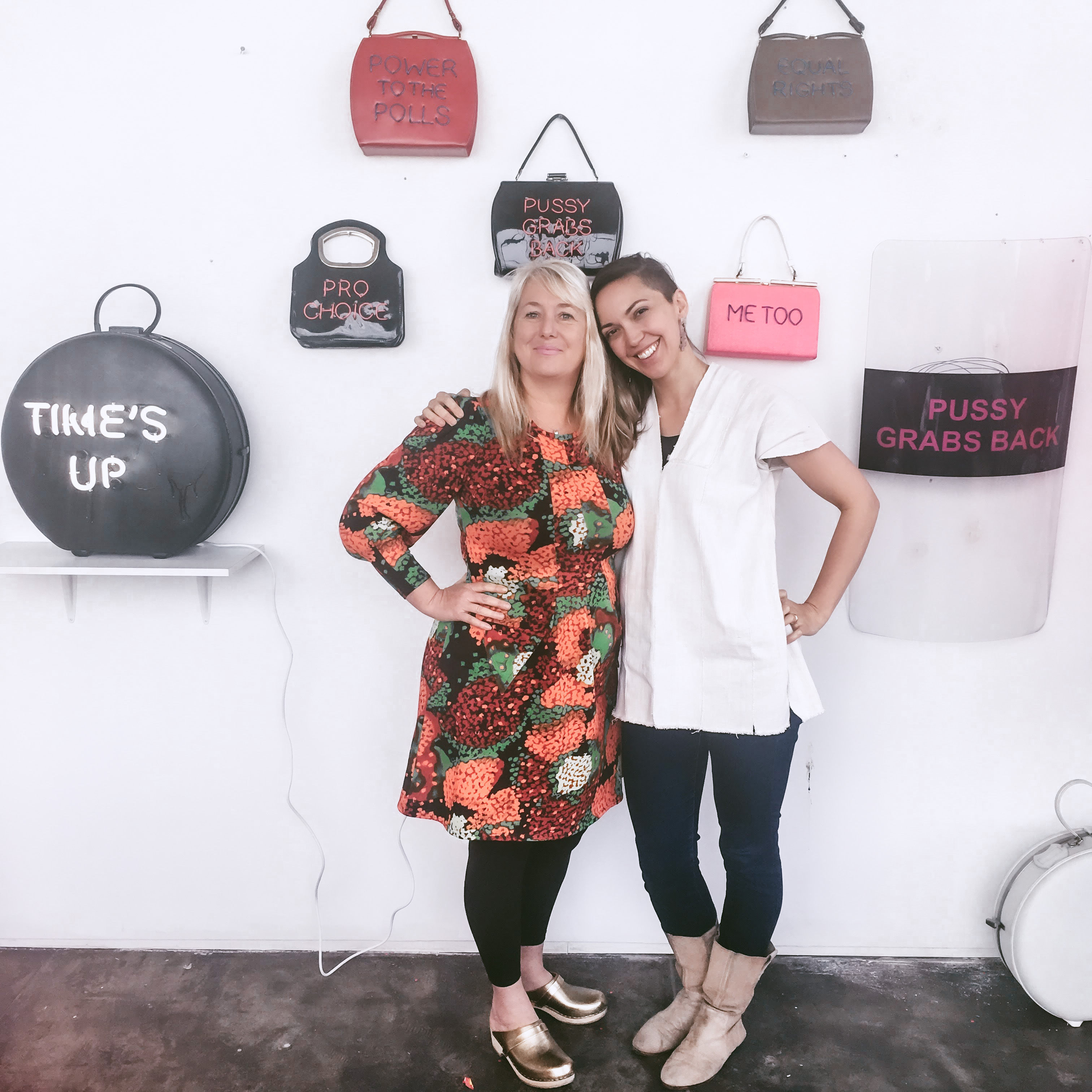
Browse Michele's website: https://michelepred.com/home.html
Michele on Instagram: https://www.instagram.com/michelepred/
Beautiful Online Thing: Immerse Yourself by Alice Marinelli
Listen to the episode
Transcription of Michele Pred's interview
Abbreviations
SV: Svea Vikander
MP: Michele Pred
BS: Bud Snow
Voiceovers in italics
__
[industrial sounds]
SV: I take the BART to Fruitvale and walk 10 minutes east.
SV: The building is like big, warehouse, it's grey, painted grey, it says FAULTLINE ART SPACE on the side. The building next to it has this huge American flag, really blowing in the wind.
SV: I check my Instagram messages for my top-secret mission instructions
SV: 'If you've never been to Faultline before, give me a text when you arrive and I'll come down and meet you.' OK... I'm texting her, I'm saying 'Hi Michele, I'm here at the red gate!'
SV: J-Fine has taken the day off in protest against American capitalism and my general flakiness so, you know, you’re stuck with me. I should let you know that Jozefien exerts a calming, pacifying influence on me and without her I am… less patient.
SV: [laughing] She says, 'Go around the other side if you have been here and know where it is, I'll meet you there.' I said, 'I haven't but I can likely find it, I am good at finding.' This is ridiculous, she should just be here. Yeah, you should be coming down to meet me. [laughter] So she says she's coming but she has to go 'kissa' real quick, 'if you know what that means,' she says. 'Kissa' means 'pee'.
SV: How could I be mad at a fellow Swede, with her unflappable natural confidence in her bodily functions?
[truck sounds] [train horn]
SV: Suddenly, the big metal gate slides open.
SV: Ok so there was a truck leaving so I just went in through the back gate. [train horn] Oh, there's a train!
SV: And there she is!
[Michele laughing]
SV: Hey! Hi!
SV: Side note, it was kind of my fault, she had given me the address to the front door of Faultline. But I came on BART and approached it by the back door. Though I mean, to be fair, it’s not always easy to tell what’s the front or the back of a warehouse, right?
[climbing metal stairs]
MP: So, do you speak some Swedish?
SV: I don't speak much.
MP: But you know what 'kissa' means.
SV: Yeah. But my dad is Swedish, he's a Swedish immigrant, so...It's nice to have the Swedish artist connection.
MP: I know!
SV: I often meet Swedes who are not artists and it never seems to work.
MP: I know [laughter] I know, I know.
SV: Right? Right?
SV: Michele walks me through the open-concept central portion of the warehouse, where several counter-height work tables are pushed together.
SV: This is awesome, I love this space. Very communal, I like it.
MP: Yeah, it is. And like, everyone starts showing up in the afternoon or midday.
SV: Yeah yeah
MP: So usually there's more people...
SV: There are two bathrooms (pretty clean!), a kitchen area, with about 10 studios leading off toward the windows, separated by low walls. Very few doors. We walk back into her studio space, which is one of the larger ones and is in the back right corner.
MP: So I've been in this space for a couple of years, after I had a child in 2009 I always had a space at home. And when I moved in with my now husband we converted a two car garage. And it just didn't have enough light for me. And I needed light. And I love light. It just invigorates me.
And then I found this space here, in East Oakland. And I love it. It's a corner space with 12-foot-high windows, lots of windows. One side facing the Oakland hills. One side facing some trees but also looking onto the 880 and you can hear the traffic. It's right next to the train tracks and so you feel life. You hear the sirens and then you can also look at the hills and see the blue sky. And so I love love love this space.
Um, I actually often work from the couch. It's just something, it just feels so relaxing. Obviously some things, many things I have to work from a table, I have several work tables in here. But some of the work I can do from my couch and it's so... It just makes me happy. A red couch in the middle of the white space with huge white walls.
SV: And where is it from?
MP: IKEA! [laughter] Swedish! I have one long wall where I sort of rotate art pieces around and have a lot of my "Power of the Purse" series up here, I have some of my feminist riot shields and I rotate for inspiration and to see how things look together. And again, it's an environment that makes you feel really inspired, to have the work up, kind of rotate it, it's kind of like a gallery wall.
SV: I just imagine this being so legitimizing! So motivating!
MP: I, yeah! Yeah. Yeah. Up here almost right above your head is called "Travelers," it is an umbrella hanging about eight feet up in the air with scissors raining down underneath it, from the "Confiscated" series, the airport confiscated series. I love the reference to surrealism, all that an umbrella can imply, I've used them a lot. So, very interactive, people wanna touch them and stand underneath them and it's powerful to have this raining down of the scissors. I also have one with bullets. It's not up right now.
This is a voting booth, I've made several pieces with voting booths. This one's just waiting until I can have time to get to it. But I've put neon pink sequin fabric over it. I just love the combination. I'm not quite sure what's going to happen with it yet but um, it is gonna be for my show in New York this fall. It's really amazing, this is actually the original curtain on it, a red white and blue striped curtain. Yes.
SV: I ask Michele to tell me about the thousands of sharp objects arranged in a 5-foot donut-like circle on her studio floor.
MP: My work, actually, is a lot about the experience or process of the hunt, the find, the discovery. I've been getting a lot of attention for the "Power of the Purse" series, and which I've of course been excited about. But I think a lot of people don't know about my full breadth of work, at this point. This piece is called "Encirclement". These items were confiscated from the airport after 9/11. They're all scissors and razor blades and corkscrews and plastic guns and matches, formed into a circle that's about 5 feet in diameter.
And I work a lot with found objects that are embedded with many, many layers of meaning. That's what's exciting for me, about an object, is taking it and dissecting it. What it signifies and culture, sharp objects were suddenly confiscated from people at airports of course represent many things, including what all of a sudden is determined to be a weapon in our society.
There's sentimental value in these items. There's globalization. Travel. Where people live, where people are going. There's cork screws from Napa valley and matches from Japan. And there's razor blades from Germany in there. And I see it as a time capsule of a time in our history that's still happening, we're still having items confiscated at the airport.
SV: I know you're wondering how she got all these things, right? Turns out, Michele was a limo driver. She spent a lot of her break time knocking on doors at the SFO airport. And eventually they just gave in and gave her all these contraband objects. She also has some magazines out on the table—there’s Vanity Fair with her purse on the front; there’s VOGUE, fancy things like that, but the one I’m interested in?
SV: Oh wow!
MP: This I had to show, I just pulled it out, I just pulled out quickly some things—
SV: Is the IKEA staff newsletter.
MP: It's translated into like 19 languages.
SV: Wow!
MP: They wrote this article! I did a shop drop in 2009, at IKEA in Emeryville. Shop dropping is when you place your artwork in a commercial environment, often a store. And I shop dropped on Black Friday, 2009, to speak about excessive consumerism, American culture, yet of course, Swedish culture has consumerism, excessive consumerism in it as well, and I'm half Swedish. So I decided to do it at IKEA, felt symbolic. I took my daughter, in her stroller, and used her as a decoy.
SV: Yep yep, nobody's a threat with a stroller [laughter]
MP: And packaged the pieces in the same size and format as their posters. And walked on in with 10 of them, into IKEA. And they thought they were returns when I came in with them under my arm and they directed me to the returns and I said, 'Oh, I'm just gonna walk through a little bit and I'll go there,' and then I went and placed them and documented them all, it's on my website.
I also had contacted press beforehand, the Oakland Tribune, which still existed at that time. So they contacted IKEA for a statement. Their national spokesperson denied that it happened because they didn't know, they hadn't seen it. I suppose they didn't say they were opposed to it but they just made a very formal, 'We did not, we are not behind this project.' But then they came around and I thought this was a really nice full circle, is that they then wrote this article in their employee magazine that gets translated into I think 19 languages and sent to all their IKEA employees all over the world, about this project. And respectfully wrote about it.
SV: Love it!
SV: And finally, it’s time to find our makeshift recording studio.
SV: We can try the bathroom. Bathrooms are often so echoey because of all the tile.
[accordion music]
MP: Right [laughter]
SV: Oh yeah, we should, we should check out up there. ... Oh, that could be interesting. [footsteps on wooden stairs] Like enclosed, cozy, lots of textiles...Maybe we can try up there. [door creaking]
MP: [echoing] Well maybe someone is, no, this is really
SV: Ah, it's echoey
MP: A little adventure!
SV: Little did you know, that's an echoey studio. Now you will always know. ...Oh this looks good. [laughter]
BS: Welcome to your lair!
SV: Yeah no, this is perfect!
SV: We settle in a cardboard darkroom.
[music]
MP: My first experience with true activism was in the 7th grade. And this was absolutely inspired by my father. I was going to Martin Luther King Junior High, in Berkeley, and noticed that the boys didn't have to wear a uniform for PE and the girls did. And I told my father about this. And obviously that's not right. Either both girls and boys wear uniforms, or neither. So he and I decided to try to change that.
He wrote the letter, I have to say. But it was from us, to the principle. And of course, one is not allowed to have sexism in any educational environments. And we received a letter back responding that they would change it. And I didn't realize at the time how empowering that was for me. There's things you can do. And you have to learn, you have to know that you can do them.
And I have to include here, being white, I mean, I am coming from a privileged background in learning these things from an early age and I acknowledge that this is something that is really important that we share with everyone that we absolutely can, everyone can—and I think people are learning that. People are feeling a lot more of that these days.
I grew up in Berkeley, between Berkeley, California, and Sweden. Grew up in a very political family. My father was a professor at U.C. Berkeley in cultural geography. Many discussions just around the dinner table. And even throughout the day. In the environments of the culture during that time. That was a time actually of the Vietnam war demonstrations. And also freedom of speech.
I mean there was a lot happening in Berkeley during that time and there was a lot of discussion, I was made very aware of it because it was sort of part of the interaction I had. Particularly with my father. And then spending time in Sweden, of course with the socialist government there and the very different attitudes toward life and rights as simple as free education and free healthcare being the norm over there. So these ideas are deeply grounded in me as being how life should be, you know, basic human rights, healthcare and education.
SV: And your mom was Swedish?
MP: Yes. My mom was, they called it back in the day, a stewardess for PanAm. And PanAm hired a group of Swedish stewardesses that they wanted to have. And even though my father was the most outspoken feminist of the two, of my mom and dad, my mom just sort of embodied feminism in her behaviour.
Coming from a really poor background in Sweden, and fighting really hard to get out there in the world, which is how she ended up becoming a stewardess and wanting to see the world. She actually was too short, they had very strict requirements, weight, height, you were ideally supposed to be blonde, she was not, you know the sort of stereotypical blonde woman. But she really outperformed herself even though she wasn't the correct height and was hired.
SV: How did she do that?
MP: She was a very strong person. And with a strong personality and she obviously persisted and I, I get that from her. Persisting is not a bad thing. I mean, there's a time and place for it but certainly for women's rights, equal rights, human rights, gun reform, there are a lot of issues right now that we need to be really persistent with. So persistence is really part of who I am, it's really really in my blood.
To create work that can hopefully empower, or inspire and create change in the world, you know? Basic human rights is a key issue for me, social justice is a key issue for me, they go hand in hand. And so it's work that I feel I need to do, I feel like it's my responsibility. What is important to me in life?
What my role, in my life, is to do, is to create work that hopefully inspires change, dialogue, thought, um, someone recently referred to my purses as a sort of call and response and I really liked that analogy. Of the purses. And in fact, she's someone who I've never met, I know through Instagram who lives in Sweden, she']s from America. And she said it's inspired her to write, about her own ideas of feminism. But the work, seeing the work, she just mentioned this on Instagram to me.
SV: Oh!
MP: Yes! And that's what I want! That's what I want, to stimulate ideas. And ignite conversations.
[musical interlude]
SV: And at what point did you decide to become an artist?
MP: I studied photography in high school and I'm not sure what I wanted to do. I had all these ideas and I felt like being creative was the best way I could express them, I'm not a writer, I couldn't be a teacher or professor I thought—which, much later I became an adjunct professor at California College of the Arts (CCA). But I started with photography at CCA and it just morphed into a lot of things.
I did an individualised major at CCA and I just started incorporating assemblage and different materials. But that's also when I started working with text and different materials, is when those ideas were really born, especially with the feminist work. So that's where some of that came from.
SV: So let's talk about purses. What do purses mean to you?
MP: Purses... [sigh] in some ways mean a woman's body. Some of the first purses from the "Power of the Purse" series that I've been doing now for a few years, said 'My body, my business,' that's a text I came up with several years ago. And other people had used it in other formats, in the body building world and, but now it's being used a lot more as sort of a feminist tag line. But they actually represent me, myself. And women. They're obviously something probably most women carry in different formats.
But the first purse collage I did—I've been doing these for a long long time—I filled one of them with a whole lot of barbed wire and cut what was sort of like a window, and put a piece of glass. So you could look into the purse and see the barbed wire. And that represented what was inside of me: a lot of pain. And so I've done collages with purses for years. They, to me, represent maybe a lot of hidden things, what you have inside of your purse, you don't necessarily always wanna share that with other people, it's very personal. And so to me they represent, you know, what's inside of us.
But also then taking these ideas and putting them on the outside. To me the purses that I'm working on now, the "Power of the Purse" series are like small scale mobile political billboards that you can walk around with. So, and spread a message, and inspire or ignite conversation or laughter or anger or many different things.
SV: In Freudian symbolism, the purse is supposed to be the vagina. This is what he thought, because he thought purses, you know, you put things in you take them out, which of course is a very male idea of what a vagina might be—
MP: [laughing] Yeah, I'd forgotten about that.
SV: But it's true that purses are coded as female,
MP: Very
SV: Very heavily coded as female and in fact that if you don't have a purse, you're kind of rogue, you're a rogue character.
MP: Right right right
SV: You're using pockets!
MP: I also just think they're beautiful in themselves. I collect these vintage purses and each one is so unique and they have a story, they've all been carried by someone. They've maybe been sitting in a closet a lot but they were part of someone's life and then now they're having a second life. And that's really interesting to me as well.
I actually, when I started making purses again (I hadn't for a long time), this was back in 2011, I started making birth control purses so they actually, and that was also about what's on the inside, what they would carry, and that's also about reproductive rights and access to birth control. So I started collaging hundreds and thousands of birth control pills on purses. And again that was about making a statement on the outside, something that we normally carry inside of our purse.
And then I started making some neon pieces. With actual neon. And on vintage train cases, the round cases, often American Tourister bags. I loved the symbolism of them as well. And that refers to traveling too, like being on an airplane, and I grew up traveling a lot, my mom the stewardess...So it hearkens back, yeah to a lot of different ideas. So I made several of these and I'm still making them.
And then what happened in 2013, I was gonna go to the Armoury fair in New York. And I had been making some of these, actual neon purses. And I'd learned about luminescent wire. And all you need is a battery. It doesn't have to be plugged into a wall. The big neon pieces are stationary. You can't walk around with them. And I thought, 'I wanna make one that I can wear. And it's gonna be about reproductive rights. It's gonna be about pro-choice.' And literally the day before I was flying out, I made a purse that said 'choice' on it.


